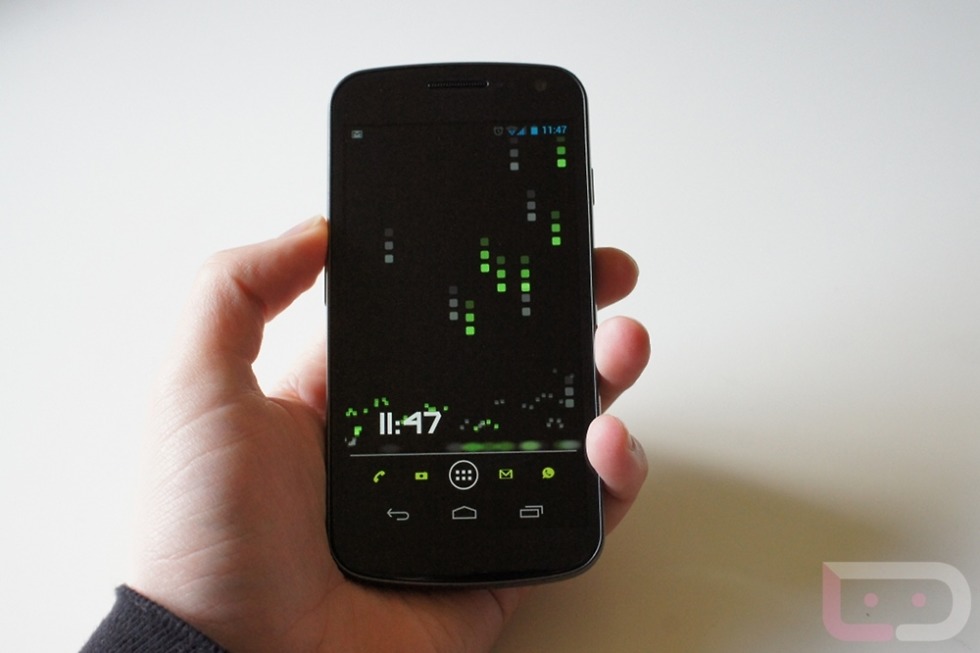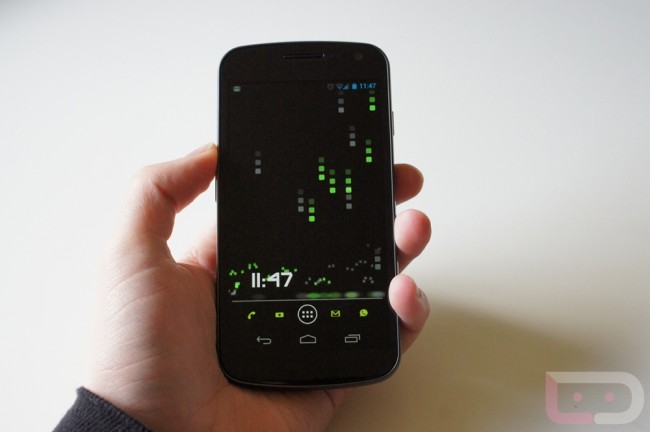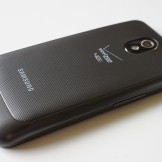As the Galaxy Nexus approached launch on Verizon here in the U.S., you couldn’t pull up an Android site without seeing some sort of rumor, tip or leak that had to do with it. This phone was hypebeasted as if it was the second coming of some religious tech figure. Over the last couple of months, things have been unbelievably wild (both positively and negatively) around these parts, and the majority of the thanks can be attributed to it. As a “Nexus” on Verizon, the release of this phone marked an industry first on a number of levels including the combination of Ice Cream Sandwich, 4G LTE, NFC, an unlockable bootloader, and the support of the entire developer community. It has been dubbed as one of the first truly finished Android products to date. With so much to live up to, we will do our best to let you know whether or not it has.
The Good:
- Hardware: The insides of the Galaxy Nexus are what you would expect from a top tier phone in 2011. It has a dual-core processor clocked at 1.2GHz, 1GB of RAM, both front and back cameras that can shoot HD video, an HD display, 4G LTE and an NFC chip. You will find ultra-enthusiasts out there claiming that Google should have done more to push the envelope, but truthfully, they didn’t need to. They optimized top notch hardware with the latest version of Android making this phone run like butter. Oh, and we should also point out that this is the only device on the planet running the OMAP4460 processor if you really need to justify it.
- Feel: In hand, I’m not sure there is a phone that feels better. Its curves and weight make the Galaxy Nexus a joy to hold. We were slightly worried about how it would feel when Samsung announced that it would sport a massive 4.65″ display, but those worries were washed away the minute we got it in hand. You will hear critics claim that the device feels cheap “like all Samsung devices” – I would beg to differ. I’ve had the Galaxy S2, Fascinate, and some of their tablets, so I know what cheap feels like. This phone, feels completely different and of a higher quality than past Samsung releases.
- Design/Build: This could have gone in the “feel” department, but that just wouldn’t be fair because the design of this phone is a work of art. With its slightly curved HD Super AMOLED display, bottom-placed headphone jack, textured back, volume and lock switch placements, and on-screen buttons, the G-Nex is easy on the eye and easy to use. If there was a design standard that manufacturers should take going forward, this and the DROID RAZR are the two phones to look at.
- Performance: We have been off the benchmark train for quite some time now, so when we talk performance, you aren’t going to see them anywhere. When we mention “performance,” we tend to go with a little thing called the feel test. And with this phone, the feel test is passed with flying colors. What we mean by that, is that the feeling you get while buzzing through home screens, switching apps, using the camera, watching video, playing games, etc. just feels great. There are no stutters, the phone never seems to get bogged down by too many processes, and no matter what you throw at it, the Nexus can complete it. Also, thanks to Ice Cream Sandwich, you can limit the number of tasks that your phone keeps in the background, making this phone as fast as you want it to be.
- NFC: NFC will some day be the future of mobile payment technology and the sharing of info between two devices. With the G-Nex, you get an NFC chip, so going forward, you are set. Now, the real struggle comes on the back end of things where we see if Verizon, AT&T and T-Mobile will allow you to have options to make those mobile payments and share information. So far they have chosen to lock it down to their yet-to-be-released NFC payment option. Thankfully this is a Nexus, and you already have other choices.
- Screen: The HD Super AMOLED display on the G-Nex is simply put, beautiful. At 316ppi, it falls short of the HTC Rezound’s 342ppi, but most human eyes won’t be seeing pixels either way. If there was one downside, it’s that the colors are a little more vibrant or cartoon-like than some may want, especially after you see the natural tones on the Rezound. No matter what though, this is as high of quality of screen as you’ll find on any phone and will not disappoint. Plus, with the phone’s ability to hide the on-screen buttons to give you a full 4.65 inches of viewing goodness, you will be searching for excuses to continue to use it.
- It’s a “Nexus”: As someone that’s life is now dedicated to Android, I look forward to seeing what Google has dubbed the next “Nexus.” It’s always the ultimate developer phone that launches with the newest version of Android before any other phone. This is what it is all about if you can’t get enough green robot. And with this being the first Nexus on Verizon, I’m not sure you will find a happier tech geek. The developer community has already flocked to this phone to give you more hacks, tweaks and ROMs than you will know what to do with. If tinkering with your phone is a must, then this is the phone to look for.
- 4G LTE: 4G LTE may kill batteries at a record pace, but we still love it. Having faster internet speeds on your phone than your home computer is something I still struggle to wrap my brain around. Couple LTE with a Nexus and you have a match made in heaven.
- Camera (speed and software): I’ll touch on the quality of the camera down below as it is most definitely not in the “good” category. As far as speed goes, no other camera phone can match the instant shutter of the Nexus. You tap on the camera button and it takes photo before you can even blink. And better yet, it’s ready to go that quickly so you can snap a whole series of photos and not even realize you have. The software is also improved with panoramic features, a whole bunch of on-device editing tools, and fancy “hipster” filters.
- Camera (video): As you will see in the 1080p sample that is attached down below, the video quality that the Nexus shoots is surprisingly good. The zooming while recording is much better than expected and time lapse recording is an added bonus. While this may never replace my HD camcorder, it will do just fine as a replacement in a pinch.
- Ice Cream Sandwich: As you all know, the Galaxy Nexus runs the newest version of Android (4.0) that has been named Ice Cream Sandwich. It’s the most advanced, polished and user-friendly version to date. If there was a time to get started with an Android device, this would be the one as ICS is the future of Android. And with ICS and the Nexus, you get some extra features like Android’s Beam sharing feature that utilizes the NFC chip. You also get the on-screen buttons that rotate with the phone instead of the built-in soft keys that most phones have. Some would argue that the real draw to the Nexus is the fact that it is the first to run Android 4.0 and they may be right. Then again, the phone coupled with ICS and the attention to detail by Google is what really makes it. If you want complete overviews and tips and tricks on Android 4.0, you will want to see our G-Nex guide to the world.
- Updates: You won’t find a phone attached to a carrier that will see updates as quickly as the Galaxy Nexus. Since it’s a “Nexus” and receives new OS updates directly from Google, you will always be on top of the Android game. Rather than seeing an OS update roll out and then asking yourself when you will see it on your skinned phone, you will be the one with the new OS watching everyone else ask that question.
The Not-so-Good:
- Camera (picture quality): If there was one thing that I think we can all agree on, it’s the fact that Google and Samsung skimped on the camera in this phone. It is just not as good as the competition at taking still shots. Forget the fact that it’s only 5MP and not the industry standard of 8MP for high end phones, the camera in this phone should be better than it is. Low or bright lit areas, the shooter here is simply not good enough when you compare it to the HTC Rezound or even the RAZR for that matter. It may not be as bad as the Bionic’s camera, but man is it pushing it. You definitely can’t expect this phone to “wow” any of your friends in the recently-snapped-photo department. Samples below:
(Click images for larger versions)
- Battery life: It’s an LTE phone, so it sucks. On either the standard or extended batteries and with LTE turned on and WiFi off, you aren’t going to get a whole day of life out of this phone. Hell, you may not even get half of a day. I hit anywhere between 6-11 hours, but the average is probably closer to the lower end of that range. If you want your phone to last for 20+ hours though, simply turn off LTE and you will never worry about battery life again. On an average day using WiFi and 3G-only, I consistently see well over 20 hours of life on the extended or standard batteries.
- Rear speaker: The rear speaker has been a pain for some, including myself at times. It has an incredibly low volume even when turned all of the way up. There are apps out there that can adjust the stock volume settings to make your external speaker louder though, just be careful that you don’t overdo it. Depending on your need for a high-pitched ringtone, this isn’t necessarily a deal breaker on this phone.
- Connection issues (for some): I haven’t run into the signal and connection issues that many of you have, but it still needs to be addressed. There are all sorts of antennae-gate signal strength issues going on with this phone, some of which have been debunked time and time again. That doesn’t mean that there aren’t Nexus owners experiencing real issues though. Some have reported that when sitting side-by-side in low coverage areas with their other 4G phones, that the Nexus can’t even lock onto LTE while the others can at least grab a couple of bars. It’s tough to tell if this can be fixed with software or if it’s even widespread. One thing is certain, if you spend the majority of your days in a low signal LTE or even 3G area, just make sure you keep track of the time you have to return it in case your Nexus struggles.
- Price: We are almost a year into the $299 on-contract phone pricing scheme and I’m still not a fan of it. I get that Verizon tested us all with the DROID Charge and a few people actually forked out that kind of change leading Big Red to push forward with this being the standard for high end LTE phones, but that doesn’t mean I can’t complain about it. And I totally get that we should expect to pay a premium for a device we use on a daily basis, yet it still seems a little much. Then again, I had no problem actually dropping Benjamins for it…so maybe this argument is completely unnecessary. Damn you ever-changing tech industry!
Gallery:
Hands-on and Overview:
Video Sample (1080p):
The Verdict:
The combination of beautiful hardware, innovative design, and software has made the Galaxy Nexus one of the first Android devices to feel “complete.” There have been few times over the last two years that I reviewed a phone and felt 100% confident in recommending it – this is one of those times. Is it the best Android phone available? Easily. While the Galaxy Nexus may have a camera that doesn’t measure up to some of the other players in the game like the HTC Rezound or DROID RAZR, there are too many other positives to make this the phone that you should check out if you have an upgrade available. Actually, if you are a tech geek that always wants to be on the leading edge of the Android world, you may also want to look to go off-contract and upgrade. After having had both the GSM and LTE versions of this phone for the last month, it has easily become my favorite Android device.
Related: Complete Galaxy Nexus “How To” Guide | Ice Cream Sandwich Features Part 1 and Part 2.
Samsung Galaxy Nexus LTE Specs | Other Galaxy Nexus Coverage




Collapse Show Comments557 Comments